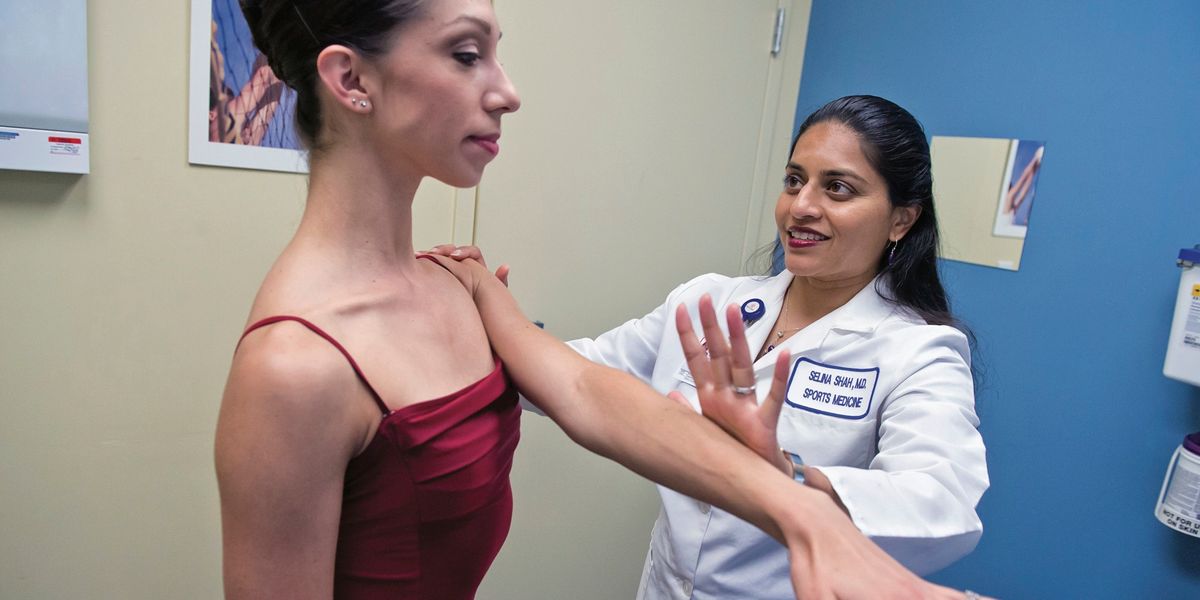The Truth About Soreness: Answers to All Your Burning Questions
We all know the feeling: You wake up the day after class or rehearsal just to find that you literally. cannot. move. To answer all your burning (pun intended!) questions about the way-too-relatable topic of soreness, Dance Spirit enlisted the experts: board-certified sports medicine specialist Dr. Selina Shah, and Michelle Rodriguez, MPT and physical therapist to Broadway shows like Carousel and Charlie and the Chocolate Factory.
What even is soreness?
If you’re working extra hard—taking more classes than usual, or dancing a super-“puffy” piece—your body’s normal aerobic metabolism (how it uses oxygen to produce energy) can get overwhelmed. That’s when anaerobic metabolism kicks in—producing lactic acid and metabolic toxins. “This buildup of lactic acid and other toxins isn’t harmful or abnormal,” says Rodriguez. “But once it reaches a certain level, you’ll experience soreness.”
How can you prevent it?
Because it’s chemical buildup in your muscles that makes you feel sore, the key to minimizing the ouch is to flush these chemicals out sooner rather than later. “For some dancers, getting on a stationary bike for five minutes with no resistance can make a difference,” says Rodriguez. You might also try self-massage, icing, or
baths (see sidebar). Otherwise, Shah says to make sure you’re taking time to warm up properly: “Doing a little bit of light cardio
and literally warming up the muscle should ease your discomfort.”
If you’ve ever been so sore that you couldn’t walk on the second or third day of a summer intensive, you’ve experienced firsthand the importance of what dance-medicine professionals call “ramping up.” While taking breaks should be part of any year-round training regimen, you don’t want to go straight from not dancing at all to dancing eight hours a day. “Soreness occurs when muscles have gotten weaker and aren’t used to working that hard that fast,” says Shah. A week or two before your intensive, start to gradually increase the amount of physical activity you’re getting each day.
What if it’s not just soreness?
Don’t freak out, but it’s important to keep in mind that some overuse injuries can feel like soreness that just doesn’t. go. away. Pay attention to how long you’ve been feeling sore, says Rodriguez: “Delayed-onset muscle soreness, or DOMS, can happen within six to eight hours, and last for 48 to 72 hours. After that, if you’re still pretty sore, you should get seen by a medical professional.”
Also pay attention to where you’re feeling sore. “Usually it’s muscles that make you feel sore, but tendons also can,” says Shah. Ligaments and bones can’t get sore—so if you feel like that’s where the pain is coming from, get it checked out.
Is soreness inevitable?
In short, yes. “Soreness isn’t necessarily a sign that something’s wrong,” says Rodriguez. Nor is it a badge of honor: “Soreness is just a marker of how strong or fit that particular muscle is in that particular dancer at that particular moment in time,” says Shah. “You may get sore in some areas where your friends don’t, and vice versa.” If you take good care of your body, though, you’ll be able to minimize the pain enough to dance full-out—even on the sore days.
The Dancer’s Soreness Toolkit

Getty Images
Massage!
Foam rolling can feel a little too intense to muscles that are already sore, says Dr. Selina Shah, so don’t roll out until a day or two after you first feel sore. Michelle Rodriguez, MPT, recommends gently kneading your own muscle tissue after a soreness-inducing day.
Stretching!
Stretching is most beneficial at the end of class or rehearsal, when muscles are warm, says Shah.
Strategic breaktime!
“If you don’t need to run to the bathroom during your five-minute break, lie on the floor with your butt up against the wall, and put your legs straight up on the wall,” suggests Rodriguez. “You can then do little ankle pumps to flush out your legs.”
#Bathleisure!
“Try alternating between hot baths and ice baths,” suggests Shah. The circulation boost caused by the change in temperature will help ease soreness.
Hydration! Sleep! Electrolytes!
Enough said.




